
3D printed objects only really come to life when you paint them. The right technology and equipment are crucial.
Painting 3D prints: These are the tools you need
3D printing has revolutionized the production of objects. But it is only through individual painting that these prints get their unique touch. In order to design your 3D print, you need the right colors.
- Acrylic paints are popular for decorating 3D prints because they dry quickly and are waterproof.
- Depending on how large your object is and how detailed the motif should be, you can either apply the paint over a large area with a spray can – the more expensive and professional option would be an airbrush device – or with a brush.
- A water cup and a mixing palette are also a must.
- For the preparatory work you will also need a primer and sandpaper (400 to 800 grit). And for the finish you will need a clear coat.
How to paint your 3D print
Before you begin, make sure your 3D print is fully cured and clean. Dust and grease can affect the paint's adhesion.
- First, sand the object with sandpaper to smooth out any small imperfections caused by printing.
- The surface will be even smoother if you apply a primer. Spray primer is particularly suitable. Apply this over a large area from a distance of 20 centimeters. If necessary, sand down any unsightly areas after they have dried. If necessary, apply another layer until the result is smooth.
- Before you start painting, consider a color scheme and plan your design. Sketch your design on the object beforehand if necessary.
- Use masking tape to create precise edges or to cover areas you don't want to paint.
- Mix the colors on a palette to get the desired tones. Practice different brush strokes on a test object before painting the print with acrylic.
- After the paint has dried, seal it with clear varnish.
Tips for professional results when painting 3D printing
The right tools and techniques can be crucial for a good result if you don't have much practice painting your prints.
- Invest in high-quality brushes in different sizes. Fine brushes are ideal for details, while wider brushes can quickly cover large areas. Real hair brushes have also proven to be useful for painting PLA.
- Try different painting techniques such as dry brushing or washing (where the paint is heavily diluted) to create depth and texture in your 3D print.
- Pay attention to the order of the paint applications. Allow each layer to dry completely before applying the next one to avoid mixing.
